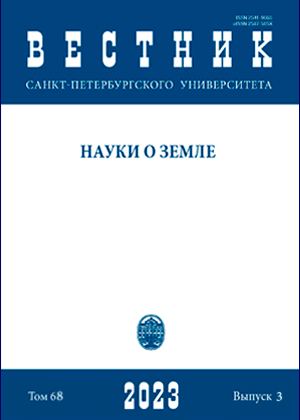Post-accident dynamics of flora and vegetation in the Belarusian sector exclusion zone of the Chernobyl nuclear power plant
DOI:
https://doi.org/10.21638/spbu07.2023.305Abstract
The issues of vegetation cover dynamics in the Chernobyl accident area considered in the article. The research carried out within the boundaries of the Polessky State Radiation-Ecological Reserve. The objects of research are the flora and vegetation of the region. The research is based on as classical methods for studying flora and vegetation, as modern ones, using a long-term archive of Landsat satellite imagery. The article interprets that the flora and vegetation transformation processes of the Chernobyl exclusion zone are mainly due to natural changes and anthropogenically stimulated processes associated with the economic activity cessation. The authors noted a progressive increase of the vascular plant species number within the Reserve, which explained by the restoration processes beginning of the vegetation cover after the population evacuation and the economic activity complete stopping. The spatial isolation of the Polessky State Radiation-Ecological Reserve territory led to the preservation of flora synanthropization level, similar to the end of the 1980s. Former settlements, wastelands, former arable lands, linear objects (roads) and other former anthropogenic habitats are the retention and penetration centers of synanthropic species within the Reserve. The forested territory increasing is a key moment of the vegetation demutational successions in the Chernobyl exclusion zone. A large increase of derived small-leaved forests participation characterizes the dynamics of the forest vegetation formational structure during the post-accident period. Indigenous coniferous and deciduous fen forests also tend to distribution increase, but their dynamics is not rapid. Forests formation, bushing, waterlogging due to the degradation of drainage systems are the processes of meadow dynamics. Fragments of unchanged meadows preserved only in the Pripyat River floodplain. Restoration of bog-forming processes observed on disturbed peatlands, part of unforested fens transformed into forested fens, sparse forests and shrub thickets in the post-accident period. The processes of forest formation, local swamping prevail on the former agricultural and residential lands.
Keywords:
Chernobyl nuclear power plant, exclusion zone, Polessky State Radiation-Ecological Reserve, flora, vegetation, biotopes, dynamics
Downloads
References
Алексахин, Р. М., Булдаков, Л. А., Губанов, В. А., Дрожко, Е. Г., Ильин, Л. А., Крышев, И. И., Линге, И. И., Романов, Г. Н., Савкин, М. Н., Сауров, М. М., Тихомиров, Ф. А., Холина, Ю. Б. (2001). Крупные радиационные аварии: последствия и защитные меры. М.: ИздАТ.
Биологическое разнообразие Полесского радиационно-экологического заповедника: сосудистые растения (2021). Минск: Беларуская навука.
Гарбарук, Д. К., Углянец, А. В., Шумак, С. В. (2020). Особенности лесообразования на бывших сельскохозяйственных землях в зоне отчуждения Чернобыльской АЭС. Ботаника. Исследования, 49, 50-61.
Груммо, Д. Г. (2022) Опыт развития прикладного тематического картографирования для решения задач мониторинга и прогнозирования состояния природных экосистем и растительных ресурсов. В: Российская геоботаника: итоги и перспективы (к 100-летию Отдела геоботаники БИН): Всеросс. конф. с международным участием. СПб., 212-214.
Дидух, Я. П., Кордюм, Е. Л., Прядко, Е. И., Сидоренко, П. Г. (1995) Фитоценотический и цитогенетический мониторинг в условиях хронического облучения в зоне ЧАЭС. В: Экологический статус загрязненных территорий: тез. докл. Междунар. раб. совещ. по Чернобыльской экологической исследовательской сети. Минск.
Дідух, Я., Кордюм, Є., Андрієнко, Т., Прядко, О., Сидоренко, П., Ситник, К. (1994). Фітоценотичний та цитогенетичний моніторінг рослинного покриву в умовах хронічного опромінення, спричиненого аварією на Чорнобильській АЕС. Киïв.
Ипатьев, В. А., Багинский, В. Ф., Булавик, И. М., Дворник, А. М., Волчков, В. Е., Гончаренко, Г. Г., Поджаров, В. К., Булко, Н. И., Бордок, И. В., Волович, П. И., Гедых, В. Б., Гримашевич, В. В., Диденко, Л. Г., Есимчик, Л. Д., Жученко, Т. А., Кейзер, Г. И., Ковалевич, А. И., Кожевников, А. М., Колодий, П. В., Копытков, В. В., Крушев, Л. Т., Марченко, Я. И., Митин, Н. В., Падутов, А. Е., Падутов, В. Е., Переволоцкий, А. Н., Пикулик, М. М., Сидор, А. И., Силин, А. Е., Степанчик, В. В., Тарасенко, В. П., Трухоновец, В. В., Усеня, В. В., Фомина, В. И., Хотылева, Л. В., Чунихин, Л. А., Шевчук, В. Е., Яцына, А. А. (1999). Лес. Человек. Чернобыль. Лесные экосистемы после аварии на Чернобыльской АЭС: состояние, прогноз, реакция населения, пути реабилитации. Гомель, Речицкая укрупненная типография.
Козубов, Г. М. и Таскаев, А. И. (2002). Радиобиологические исследования хвойных в районе Чернобыльской катастрофы. М.: Дизайн. Информация. Картография.
Кудин, М. В., Гарбарук, Д. К., Маленок, Л. В., Турчин, Л. М. (2014). Флора сосудистых растений Полесского государственного радиационно-экологического заповедника. Особо охраняемые природные территории Беларуси. Исследования, 9, 85-125.
Турчин, Л. М. (2019). Находки аборигенных и адвентивных видов растений в Полесском государственном радиационно-экологическом заповеднике. В: Флора и растительность в меняющемся мире: проблемы изучения, сохранения и рационального использования: Межд. научн. конф. Минск, 115-156.
Турубанова, С. А., Крылов, М. А., Потапов, П. В., Тюкавина, А. Ю. (2017). Анализ динамики лесного покрова Восточной Европы на основе спутниковых данных с 1985 по 2012.Russian Journal of Ecosystem Ecology, 2 (1), 1-11. https://doi.org/10.21685/2500-0578-2017-1-3
Флора и растительность Полесского государственного радиационно-экологического заповедника (2002). Мозырь: Белый Ветер.
Черная книга флоры Беларуси: чужеродные вредоносные растения (2020). Минск: Беларуская навука.
Щеглов, А. И. (1999). Биогеохимия техногенных радионуклидов в лесных экосистемах: по материалам 10-летних исследований в зоне влияния аварии на ЧАЭС. М.: Наука.
Экологические последствия аварии на Чернобыльской АЭС и их преодоление: двадцатилетний опыт: докл. эксперт. группы «Экология» Черноб. Форума (2008). Вена: МАГАТЭ.
Юркевич, И. Д. и Гельтман, В. С. (1965). География, типология и районирование лесной растительности Белоруссии. Минск: Наука и техника.
Юркевич, И. Д., Голод, Д. С., Адерихо, В. С. (1979). Растительность Белоруссии, ее картографирование, охрана и использование. Минск: Наука и техника.
Potapov, P. V., Turubanova, S. A., Tyukavina, A., Krylov, A. M., McCarty, J. L., Radeloff, V. C., Hansen, M. C. (2014). Eastern Europe’s forest cover dynamics from 1985 to 2012 quantified from the full Landsat archive. Remote Sensing of Environment, 159, 28-43.
Weck, J. (1956). Entwicklungsstufen und Gefügetypen von Baumbeständen. Forstwissensch. Centralblatt, 75 (3/4), 108-124.
Downloads
Published
How to Cite
Issue
Section
License
Articles of "Vestnik of Saint Petersburg University. Earth Sciences" are open access distributed under the terms of the License Agreement with Saint Petersburg State University, which permits to the authors unrestricted distribution and self-archiving free of charge.






